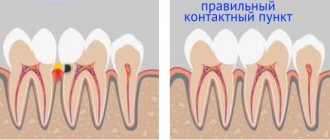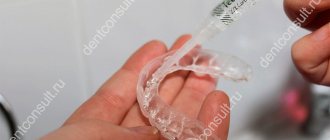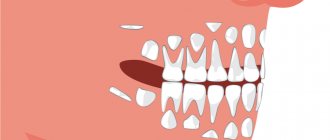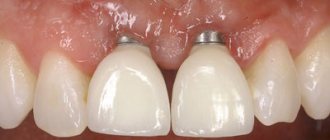Third molars do not always grow in
This is true. The formation of “eights” does not occur during uterine development, but at the age of 3-5 years. But even if their rudiments are present, eruption does not always occur. The fact is that they begin to grow at the age of 17-25 - at the age when the jaw bone has already completed its formation and the dentition is complete. And there is no room for wisdom teeth.
Often their growth is hampered by the seventh molar. The process of teething occurs individually for each person. Sometimes 1-2 units may grow, while the rest remain hidden by the gum. In some situations, none of the “eights” grows.
But there are also cases (about 8%) when people do not have the rudiments of wisdom teeth at all. In men, the upper molars often do not develop, and in women, the lower molars do not develop. That is why the norm is considered to be 28-32 teeth.
Indications, contraindications and conditions for transplantation
Tooth reimplantation is possible if there is a donor who matches the root system of the missing unit. Simply put, it is impossible to transplant a tooth that has 4 roots in place of a two-rooted one. Another condition is that the donor must be healthy.
The main indication for transplantation is young age (up to 18 years), when implantation has not yet been performed.
The list of contraindications is extensive:
- diabetes;
- general diseases – nervous, cardiac, endocrine;
- oncological diseases;
- mental disorders;
- intolerance to anesthesia;
- slow bone tissue regeneration.
The main problem: the availability of a donor. Wisdom tooth transplant is the most common method.
"Eights" have long lost their functionality
In ancient times, people ate raw meat, roots, and they needed massive molars to chew solid food. Over time, people began to consume thermally processed, softer foods, and the urgent need for the most distant units disappeared. However, you should not completely discount them.
Despite the fact that they themselves do not take much part in chewing food, “eights” restrain the loosening of the teeth, which bear the main chewing load. And in old age they can serve as a support for a bridge.
When can you save wisdom teeth?
Despite the fact that modern people have virtually no need for wisdom teeth, they still have practical benefits. Firstly, they can participate in chewing food, however, provided that they grew up opposite each other, that is, they are antagonists - only in this case will they bear the correct load. Secondly, if they have grown straight, without disturbances, and are completely healthy, they can be used as a support for a bridge or removable prosthesis.
Therefore, if the eights do not have any violations, if the conditions that accompany their growth (inflammation of the gingival hood, pain) can be stopped, if their position allows for treatment of caries or even pulpitis in the future, you should try to save the teeth for as long as possible, because removal is always last resort.
When treating “wise” teeth, classical infiltration anesthesia is used. On the lower "eights", as a rule, a conductor is used - it is more efficient and allows you to capture a larger area. The effect of its influence and lack of sensitivity persists for a long time.
In 70-80%1 of cases, upper wisdom teeth are easier to treat than lower ones. But even if pulpitis occurs, there is no need to rush - a tooth without a nerve will be lifeless, but it can last for many more years.
Removing eights is not always a justified operation. Therefore, we resolve such issues on a strictly individual basis. First of all, we carry out x-ray diagnostics, determine the location of the tooth roots, and assess the condition of the bone tissue and gums around. If the tooth grows evenly and does not put pressure on its neighbors, we save it. When it is impossible to do without removal, we prescribe an operation, which can be performed under sedation or general anesthesia. Removing impacted wisdom teeth is a rather complicated procedure, but all surgeons at our clinic have extensive experience, which eliminates the risk of complications after surgery
Indications for removal
- complete retention of a wisdom tooth, when it has not fully erupted and is in a curved position inside the bone tissue, causes pressure on the roots of its neighbors. In such situations, removal must be carried out as quickly as possible, since the consequences of such a pathology can make themselves felt at any moment,
- partial retention: if it has erupted only partially and has been in this state for several years or months. It is worth noting that eights grow slowly, so if a tooth cannot grow for a long time, you should consult a doctor, even if there is no discomfort. Perhaps this is the limit of growth for him,
- dystopia, which leads to malocclusion or displacement of neighboring ones. It is also necessary to remove in cases where an incorrectly positioned tooth injures the mucous membranes,
- impossibility of conservative treatment,
- destruction due to mechanical influences: when it is not possible to carry out restoration with a crown, and the broken part goes under the gum,
- purulent exacerbations: periodontitis, periostitis, cysts or granulomas, which are fraught with the spread of infection throughout the body,
- orthodontic correction of the bite: studies2 show the justification for removing figure eights if they interfere with the installation of orthodontic appliances and changing the position of other teeth.
The eruption of “figure eights” is almost always associated with complications
Difficulties in eruption of third molars are caused not only by lack of space, but also by the fact that they do not have deciduous predecessors. Therefore, they often grow only partially or at an angle. But even the appearance of units growing correctly in most cases causes complications.
Most often found:
- destruction or displacement of adjacent teeth;
- bite problems;
- pericoronitis.
Very often, the eruption of the figure eight is accompanied by a purulent-inflammatory process. This happens because a hood appears over the tooth, and around it there is a pocket in which bacteria, plaque and food debris accumulate. They create favorable conditions for the development of inflammation (pericoronitis).
Often, when the eighth tooth appears, severe pain is felt, which occurs due to oppression of the roots of neighboring units.
Wisdom tooth removal: procedure
Removal of the “eight” can occur under both local and general anesthesia. This depends on the patient’s pain threshold, his psychological state, as well as the complexity of the upcoming operation. The doctor must also find out whether the patient has an individual intolerance to specific components of the anesthetic drug.
Wisdom teeth removal can be simple or complex.
Simple removal takes place in 5-10 minutes (excluding the waiting time for anesthesia to take effect). The doctor simply loosens and then pulls out the tooth using special tools. After this, the wound is either sutured or packed.
The need for sutures always depends on the doctor's decision. Experienced specialists prefer not to omit this stage, because it reduces the risk of inflammatory processes in the oral cavity.
Difficult removal occurs when the tooth has either not yet fully erupted or has curved and branched roots. There are also cases when the figure eight crown has a lot of damage, making it quite difficult to grab with forceps.
In some cases, after anesthesia, the doctor needs to make an incision in the gum tissue, as well as drill out bone tissue or saw a tooth. Complex removal must be completed with suturing.
Eighth teeth are more likely than others to suffer from caries and other diseases.
This is due to their remote location and the inability to thoroughly clean them. Which leads to a large accumulation of bacteria and the development of caries, gingivitis, and periodontitis. Treatment in such situations is possible, but filling is often complicated by twisted roots and canals. Also, many people cannot open their mouths wide enough or some have a pronounced gag reflex - this significantly complicates the dentist’s work. Due to objective reasons, the “eights” are treated poorly.
Therefore, if the patient wants to keep the unit, a consultation with a dentist is required, who can professionally assess the situation and make the right decision.
Wisdom teeth need to be removed early
There is still debate in the dental community about the need to remove third molars in advance, even if they do not bother you. However, most experts are still inclined to believe that this is not worth doing. Scientists do not have sufficient evidence that preventive removal can preserve oral health in the future.
Indications for tooth extraction are:
- its incorrect location;
- lack of space for teething;
- destruction of the adjacent seventh molar;
- deep caries (pulpitis, periodontitis);
- crowding of units;
- inflammation of the hood.
In these cases, there is no point in fighting for the G8. And, if it is not possible to save the molar, you should think about choosing a dentistry where experienced professionals will remove the tooth.
Save forever
How to properly take care of your dental health in order to preserve them until old age?
Olga, Moscow
– The main principle of maintaining dental health is compliance with primary prevention measures, which can be divided into three types – state, family and personal. If we talk about the state prevention system, today people are more concerned not about the availability of dental care, but about its cost. The problem is partly solved by the Compulsory Health Insurance Fund, which covers the costs of emergency dental care (treatment of caries, pulpitis and much more).
Family prevention is, first of all, traditions that are observed in everyday life. If parents are accustomed to taking care of their teeth and regularly attend preventive dental examinations, then their child will definitely learn this behavior model in the future. As for personal prevention, it includes proper nutrition and a high level of oral hygiene. And here you can’t do without regular examinations with a doctor, who will not only professionally remove plaque, but also give individual recommendations on the selection of hygiene products.
Dental health also depends on diet. For example, products containing coarse fiber (fresh vegetables, fruits) act as a natural toothbrush that effectively cleans plaque. In addition, vitamin C is necessary for dental health. It is responsible for the condition of the tissues surrounding the tooth, and most cases of tooth loss are associated with gum disease.
"Forbidden." 10 foods that are enemies of tooth enamel Read more
Removing "eights" is always difficult
If the unit is located correctly and does not have serious pathologies, it will not be difficult to remove it. To carry out the removal without the risk of complications, before the procedure the patient is prescribed an X-ray of the tooth.
However, most often the third molar grows incorrectly, partially erupts or becomes intertwined with neighboring roots. In this case, the intervention will be carried out in a complex way. The final decision on the choice of method is made by the doctor after examination and obtaining the results of an x-ray of the tooth.
When using a complex method, manipulations are performed in the following sequence:
- The gum is cut and peeled away from the bone.
- To access the roots, a hole is drilled into the bone.
- The unit is extracted (in whole or in parts).
- The wound is treated and stitches are applied.
The procedure can take from 20 minutes to 2 hours. Everything is individual and only an experienced doctor can professionally perform the removal. Therefore, you should be careful when choosing a clinic and specialist.
After surgery, it is recommended to eat soft foods and refrain from physical activity for several days. Antibacterial therapy may be prescribed for prophylactic purposes. Pain and swelling persist for 3-4 days and then gradually disappear.
Visiting the dentist immediately after the figure eight begins to erupt will save you from many serious complications.
Complex dentistry "Sanident" invites all residents of Ivanteevka and Shchelkovo to use the services of experienced dentists who can cope with any dental disease.
Changes in bone
Bone tissue, in the area where there are teeth, constantly experiences a certain load, which is transmitted to it through the teeth during the process of chewing food. Thanks to this load, the proper functioning of the bone occurs, that is, the balance of osteoblasts (cells that provoke bone growth) and osteoclasts (cells that provoke bone breakdown) is maintained. If a tooth is missing, the balance of the above-mentioned cells is disrupted in favor of osteoclasts, and therefore, bone tissue atrophy. That is, the bone ridge, where a tooth has been missing for a long time, becomes narrow at the top, and upon lateral examination there is a significant dip on the buccal surface.
Rice. 1 – Bone atrophy
It should be noted that the longer a tooth is missing, the more pronounced is the atrophy of bone tissue. Everything would be fine, but further restoration of the missing tooth is not possible without restoring the volume of the bone. Bone grafting and gum grafting are required. Of course, modern dentistry has reached great heights in maxillofacial surgery and various types of plastic surgery, which are performed quite quickly and successfully. But in any case, this is a complex surgical intervention that could have been avoided by simply replacing the lost tooth in time. In addition, the final result, when interacting with the bone, is delayed, and six months, this is exactly the period required, for the bone to return to normal and become suitable for implantation.
Rice. 2 – The process of replacing a lost tooth











